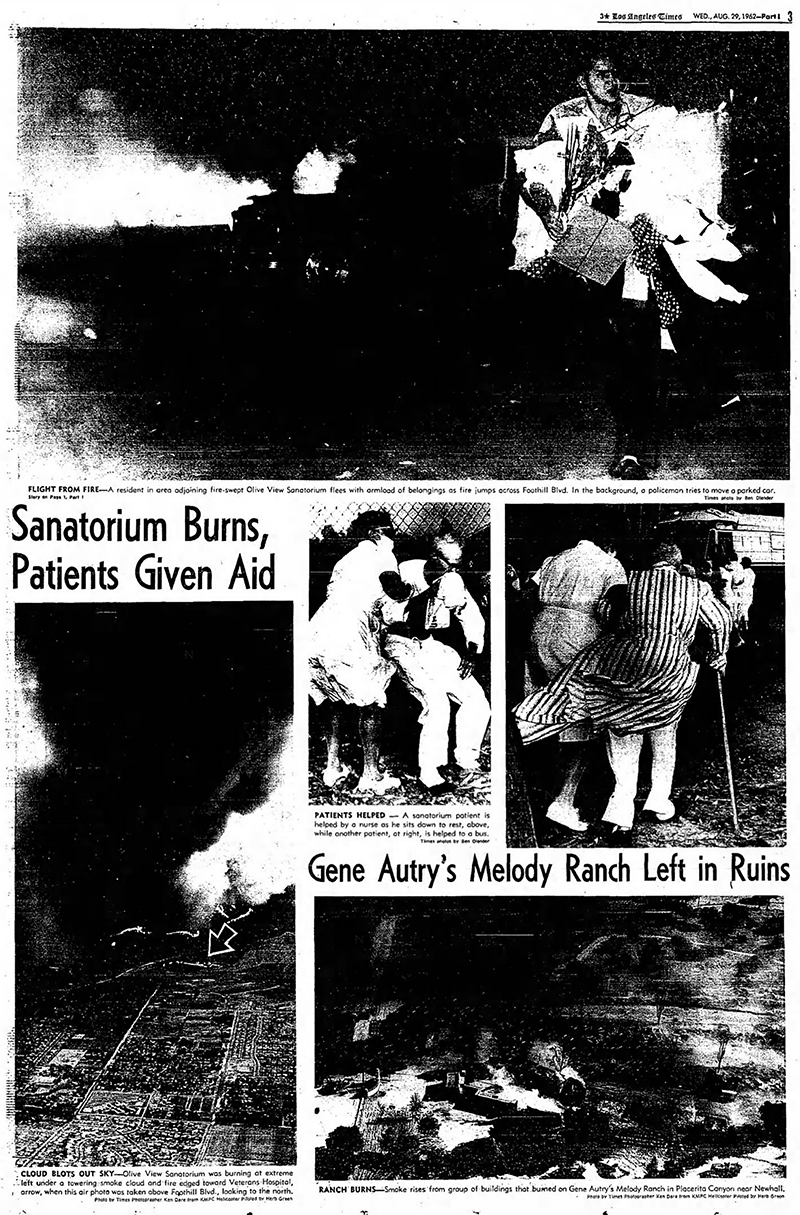|
|


Click image to enlarge
August 28, 1962 — Near Olive View Sanitarium in Sylmar, a man flees from a fast-moving fire that started earlier in the day at Circle J Ranch and blew through Placerita Canyon, taking out Gene Autry's Western town at Melody Ranch before dropping down into northeastern San Fernando Valley. Photograph by Los Angeles Times staff photographer Ben Olender (1926-1998), whose name and title are stamped on the back of this 11x14-inch print. A typewritten notation on the back of an old L.A. Times photo assignment form reads:
"TIME TO LEAVE" [by] Ben Oldender
Shows resident with only belongings in 1962 Placerita Canyon fire. This photograph was published in the Times on Aug. 29, 1962. Cutline reads:
FLIGHT FROM FIRE — A resident in area adjoining fire-swept Olive View Sanitarium flees
with an armload of belongings as fire jumps across Foothill Blvd. In the background,
a policeman tries to move a parked car.
About the Photographer.
[L.A. Times, July 14, 1998] — Ben Olender, award-winning Times photographer for three decades who specialized and delighted in recording sports events, has died. He was 72. Olender, who shot for The Times from 1958 until 1986, died Thursday at his home in Palm Springs, his family said. In February, the versatile photographer received a lifetime achievement award from the Press Photographers Assn. of Greater Los Angeles. He had served three terms on the organization's board and was its president in 1970. In 1973, Olender was nominated for a Pulitzer Prize for his photograph of a Vietnam prisoner of war greeting his 9-year-old daughter upon his return to the United States and freedom. The photographer considered that image his finest work, his son, Don, said. Olender received several awards for his sports photography, including the 1968 and 1978 best sports photo award from the Greater Los Angeles Press Club and the 1970 best sports photo award from the California/Nevada Associated Press. Born June 1, 1926, in Wyandotte, Mich., Olender grew up in Syracuse, N.Y. After serving as a Marine turret gunner in the South Pacific during World War II, he bought his first camera and put it to use for the Syracuse Herald-Journal. In 1949, the Associated Press offered him a job in Los Angeles. He next spent eight years as chief photographer for the Pasadena Star-News before joining The Times. Olender is survived by his wife, Dolores "Dodie" Warren; his five children, Dave, Don, Denise, Dan and Dorothy, and eight grandchildren. Funeral services are scheduled at 10 a.m. today in Palm Springs Mortuary in Cathedral City, with burial at 2:30 p.m. in Veterans National Cemetery in Riverside. The family has asked that any memorial donations be made to the American Heart Assn. The first blaze broke out just after noon in Hasley Canyon, north of Castaic Junction. The second broke out an hour later near the Circle J Ranch between Newhall and Saugus. High winds whipped the flames into the most intense inferno anyone had ever seen. When the smoke cleared three days later, 17,200 acres had been scorched and 15 structures and numerous out-buildings were lost. No one was killed, but the Western street at Melody Ranch was gone. "I had always planned to erect a Western museum there," Autry remembered in 1995, "but priceless Indian relics and a collection of rare guns, including a set used by Billy the Kid, went up in smoke. Thank God, the ranch hands and all 14 of our horses were uninjured." Further Reading: 800 TB Patients Flee Fire; Homes, Autry Ranch Razed (AP 8-29-1962) My Memories Of Melody Ranch by Gene Autry, 1995 Melody Ranch: Movie Magic in Placerita Canyon
LW2989: 9600 dpi jpeg from original photograph purchased 2017 by Leon Worden.
|
• AP Full Story
Melody 8-28-1962
Oil Tank 8-28-1962
SFV (Mult.)
Man Flees 8-28-1962
Melody 8-29-1962
Olive View: Aftermath 1962
Salvaged Buckle
Salvaged Whip
Salvaged Conchos
Salvaged Curb Bit
Salvaged Iron
|
The site owner makes no assertions as to ownership of any original copyrights to digitized images. However, these images are intended for Personal or Research use only. Any other kind of use, including but not limited to commercial or scholarly publication in any medium or format, public exhibition, or use online or in a web site, may be subject to additional restrictions including but not limited to the copyrights held by parties other than the site owner. USERS ARE SOLELY RESPONSIBLE for determining the existence of such rights and for obtaining any permissions and/or paying associated fees necessary for the proposed use.











